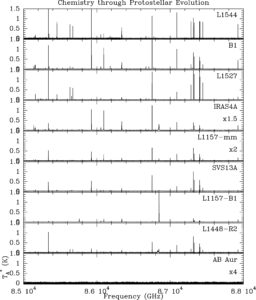Astrochemical Surveys At IRAM

This image from the APEX telescope, of part of the Taurus Molecular Cloud, shows a sinuous filament of cosmic dust more than ten light-years long. In it, newborn stars are hidden, and dense clouds of gas are on the verge of collapsing to form yet more stars. The cosmic dust grains are so cold that observations at submillimetre wavelengths, such as these made by the LABOCA camera on APEX, are needed to detect their faint glow. This image shows two regions in the cloud: the upper-right part of the filament shown here is Barnard 211, while the lower-left part is Barnard 213. The submillimetre-wavelength observations from the LABOCA camera on APEX, which reveal the heat glow of the cosmic dust grains, are shown here in orange tones. They are superimposed on a visible-light image of the region, which shows the rich background of stars. The bright star above the filament is φ Tauri.
The ASAI project addresses the question of our “chemical origins”, namely the chemical evolution of the matter during the long process that brought it from prestellar core to protostars and their associated outflows, protoplanetary disks, and ultimately to the bodies of the Solar System. This project is led by B. Lefloch (IPAG, France) and R. Bachiller (OAN, Spain) and joins the efforts of nearly all specialists in Astrochemistry in Spain and France.
Systematic spectral line surveys constitute the most powerful diagnostic tool to carry out a comprehensive study of the chemical evolution of star-forming regions. ASAI makes full use of the EMIR receivers at the IRAM 30-meter telescope to carry out an unbiased spectral exploration of a carefully selected sample of 10 template sources, covering the full formation process of solar-type stars, from prestellar cores to solar-type protostars (including jets and outflows) to protoplanetary disks.

Spectral line cutouts of sources in various stages of protostellar evolution – ASAI Legacy Programme
The main goal is to obtain a complete, high-sensitivity census of the gas chemical composition, including pre-biotic molecules, and its evolution along the main stages of the star formation process, from prestellar cores and protostars to protoplanetary disks. The resulting data set will remain as a reference database for astrochemists (astronomers, chemists, and theoreticians), while triggering many follow-up studies. It constitutes a big step forward in the understanding of molecular complexity of the infancy of our own solar system. Our goal is to determine the chemical composition in all the ASAI source sample and compare with chemical models in order to understand how the molecular complexity builds up and what it depends on. The measured abundances will then be compared to state of the art astrochemical models, providing a laboratory where the various parameters which any model depends on, are covered by the selected sources. Source inter-comparison will permit to better constrain the parameter space, in particular assess the importance of age and/or the physical conditions.
The official ASAI repositories are at OAN and IRAM. The ASAI database provides fully reduced, calibrated spectra.
Please do not hesitate to contact Bertrand Lefloch and Rafael Bachiller to tell them about your use of the data for scientific analysis. The following acknowledgement would be appreciated: “This work made use of ASAI “Astrochemical Surveys At IRAM” (Lefloch, Bachiller, Gonzalez et al. 2017).” Acknowledgement of the ASAI project is also appreciated if data are used in public presentations.
Last update : June 2017

